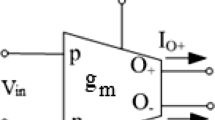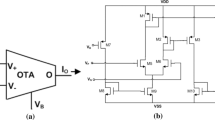Abstract
A simple and robust design for CMOS realization of a tunable grounded meminductor using three operational transconductance amplifier (OTA) and two capacitors have been proposed. Both theoretical analyses and simulation using Cadence Virtuoso at 0.18 \(\upmu {m}\) CMOS technology parameters verify the validity of the meminductor. Its meminductance can be tuned with the help of external bias voltage and has an operating frequency of 10 MHz, which makes it suitable for high-frequency applications. The proposed meminductor can also be configured using both incremental and decremental mode by interchanging the pin of OTA. Various parameters variability analysis like process variation, capacitor variation, voltage variation, temperature variation, and frequency variation has been carried out and our proposed meminductor has shown excellent performance.











Similar content being viewed by others
References
Chua, L. (1971). Memristor-The missing circuit element. IEEE Transactions on Circuit Theory, 18(5), 507–519. https://doi.org/10.1109/TCT.1971.1083337.
Ventra, M. Di, Pershin, Y. V., & Chua, L. O. (2009). Circuit elements with memory: Memristors, memcapacitors and meminductors. Proceedings of the IEEE, 97(10), 1717–1724. https://doi.org/10.1109/JPROC.2009.2021077.
Driscoll, T., Quinn, J., Klein, S., Kim, H. T., Kim, B. J., Pershin, Y. V., et al. (2010). Memristive adaptive filters. Applied Physics Letters, 97(9), 093502. https://doi.org/10.1063/1.3485060.
Sung, H., Chang, T., Ebong, I., Bhavitavya, B. B., Mazumder, P., & Lu, W. (2010). Nanoscale memristor device as synapse in neuromorphic systems. Nano Letters, 10(4), 1297–1301. https://doi.org/10.1021/nl904092h.
Hu, Z. H., Li, Y. X., Jia, L., & Yu, J. B. (2010). Chaotic oscillator based on current-controlled meminductor. In Proceedings of IEEE ICCCAS, pp. 820-823. https://doi.org/10.1109/ICCCAS.2010.5581866.
Yesil, A., Babacan, Y., & Kacar, F. (2018). Design and experimental evolution of memristor with only one VDTA and one capacitor. IEEE Transactions on Computer-Aided Design of Integrated Circuits and Systems, 38(6), 1123–1132. https://doi.org/10.1109/TCAD.2018.2834399.
Shin, S., Kim, K., & Kang, S. M. (2010). Memristor applications for programmable analog ICs. IEEE Transactions on Nanotechnology, 10(2), 266–274. https://doi.org/10.1109/TNANO.2009.2038610.
Strukov, D. B., Stewart, G. S., & Williams, R. S. (2008). The missing memristor found. Nature Letters, 453, 80–83. https://doi.org/10.1038/nature06932.
Sozen, H., & Cam, U. (2016). Electronically tunable memristor emulator circuit. Analog Integrated Circuits Signal Process, 89(3), 655–663. https://doi.org/10.1007/s10470-016-0785-2.
Sanchez- Lopez, S., Mendoza-Lopez, J., Aguilar, M. A., & Montero, C. M. (2014). A floating analog memristor emulator circuit. IEEE Transactions on Circuits and Systems II: Express Briefs, 61(5), 309–313. https://doi.org/10.1109/TCSII.2014.2312806.
Vista, J., & Ranjan, A. (2019). Simple floating MOS memristor for high frequency application. IEEE Transactions on Very Large Scale Integration (VLSI) Systems, 27(5), 1186–1195. https://doi.org/10.1109/TVLSI.2018.2890591.
Biolek, D., Bajer, J., Biolkova, V., Kolka, Z. (2011). Mutators for transforming non-linear resistor into memristor. In 20th European Conference on Circuit Theory and Design (ECCTD), pp. 488-491. https://doi.org/10.1109/ECCTD.2011.6043393.
Fitch, A. L., Iu, H. H. C., Wang, X. Y., Sreeram, V., Qi, W. G. (2012). Realization of an analog model of memristor based on lightdependent resistor. In IEEE international symposium on circuits and systems, pp. 1139–1142. https://doi.org/10.1109/ISCAS.2012.6271433.
Pershin, Y. V., & Di Ventra, M. (2011). Emulation of floating memcapacitors and meminductors using current conveyors. Electronics Letters, 47(4), 243–244. https://doi.org/10.1049/el.2010.7328.
Liang, Y., Yu, D. S., & Chen, H. (2013). A novel meminductor emulator based on analog circuits. Acta Physica Sinica, 62(15), 158501. https://doi.org/10.7498/aps.62.158501.
Kanyal, G., Kumar, P., Paul, S. K., & Kumar, A. (2018). OTA based high frequency tunable resistorless grounded and floating memristor emulators. AEU-International Journal of Electronics and Communications, 92, 124–145. https://doi.org/10.1016/j.aeue.2018.05.027.
Kumar, R., Kursun, V. (2006). Impact of temperature fluctuations on circuit characteristics in 180nm and 65nm CMOS technologies. In IEEE international symposium on circuits and systems, pp. 1–5. https://doi.org/10.1109/ISCAS.2006.1693470.
Biolek, D., Biolek, Z., & Biolkova, V. (2011). PSPICE modelling of meminductor. Analog Integrated Circuits and Signal Processing, 66, 129–137. https://doi.org/10.1007/s10470-010-9505-5.
Pershin, Y. V., & Di Ventra, M. (2010). Memristive circuits simulate memcapacitors and meminductors. Electronics Letters, 46(7), 517–518. https://doi.org/10.1049/el.2010.2830.
Liang, Y., Chen, H., & Yu, D. S. (2014). A practical implementation of a floating memristor-less meminductor emulator. IEEE Transactions on Circuits and Systems-II: Express Briefs, 61(5), 299–303. https://doi.org/10.1109/TCSII.2014.2312807.
Sah, M. P., Budhathoki, R. K., Yang, C., & Kim, H. (2014). Charge controlled meminductor emulator. Journal of Semiconductor Technology And science, 14(6), 750–754. https://doi.org/10.5573/JSTS.2014.14.6.750.
Vista, J., & Ranjan, A. (2020). High frequency meminductor emulator employing VDTA and its application. IEEE Transactions on Computer-Aided Design of Integrated Circuits and Systems, 39(10), 2020–2028. https://doi.org/10.1109/TCAD.2019.2950376.
Author information
Authors and Affiliations
Corresponding author
Additional information
Publisher's Note
Springer Nature remains neutral with regard to jurisdictional claims in published maps and institutional affiliations.
Rights and permissions
About this article
Cite this article
Raj, A., Kumar, K. & Kumar, P. CMOS realization of OTA based tunable grounded meminductor. Analog Integr Circ Sig Process 107, 475–482 (2021). https://doi.org/10.1007/s10470-021-01808-z
Received:
Revised:
Accepted:
Published:
Issue Date:
DOI: https://doi.org/10.1007/s10470-021-01808-z




